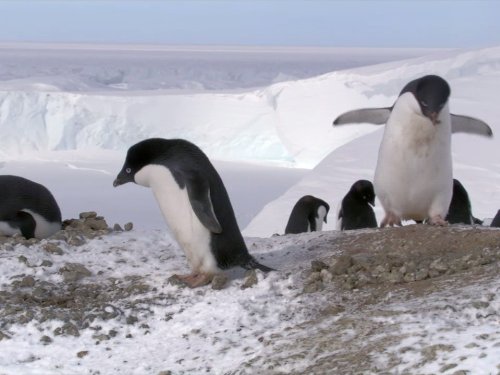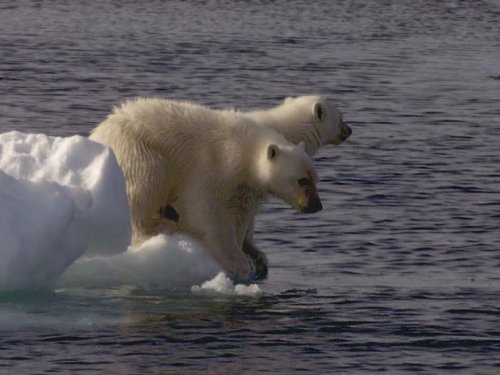Self - Narrator es una persona real interpretada por David Attenborough en la serie de televisión Planeta helado (basada en hechos reales).
Cuando se emitio el primer episodio en el que aparece, titulado To the Ends of the Earth (temporada 1), tenia 85 años.
Aparece en 8 episodios de un total de 10 episodios emitidos y ha acumulado 371 votos positivos.
Self - Narrator es interpretado también por Alec Baldwin.

Episodios 8

To the Ends of the Earth
episodio S1.E1 marzo 2012David Attenborough travels from the Arctic to the Antarctic to discover magical new ice worlds inhabited by the most extraordinary animal survivors on Earth.
Spring
episodio S1.E2 marzo 2012Each spring, massive sweet water thawing rapidly transforms the polar regions and the surrounding seas, where broken-off ice floats to. This is crucial in the life cycle of many species, sometimes extremely elaborate. Many colonies (re)unite to mate, hatch and/or start raising offspring, especially in 'temperate' parts, such as South Georgia island.
Summer
episodio S1.E3 marzo 2012In Summer, the non-stop sunlight fires an unrelenting thaw, transforming much of the polar regions into fertile land and open sea, while immense masses of melted sweet water pour into the oceans. Many species profit from the relatively benign conditions to mate, breed and raise their young. However for some, such as ice-bears, the lack of ice also causes major troubles in foraging and just moving around.
Autumn
episodio S1.E4 abril 2012After non-stop summer months, the polar regions have expanded maximally, abundant food turns even the bears sociable. However the shortening of days soon starts reversing the process as frost expands the ice again. So many seasonal migrations turn too, mainly leaving for warmer regions. A stunning exception are the 'giant' emperor penguins, who arrive to mate, lay and raise their eggs in heroic defiance of the planet's harshest conditions.
Winter
episodio S1.E5 abril 2012The polar struggle to survive is even harder in winter, missing a single rare prey can be lethal. Well-adapted anatomy is crucial, but also tricks such as isolation with snow or preys' fur. The Antarctic is nearly deserted, except for seals and emperor penguins, even the slightly milder Artic is left by most species, failing to do so is a gamble which can exterminate entire populations.
The Last Frontier
episodio S1.E6 abril 2012The polar regions are earth's least hospitable environment, yet people live in the Arctic regions. Modern urbanized life is possibly even there thanks to technology, but some (often tribal) communities still practice traditional methods, dependent on specific fauna, such as reindeer herding, dog sleds, hunting seals and collecting bird eggs. Some of those are even used by modern patrols in mineral-rich parts, e.g. in Greenland. The even harsher Antartic, were territorial claims are frozen, remains off-limits for exploitation, except controlled eco-friendly tourism and scientific research.
On Thin Ice
episodio S1.E7 abril 2012David Attenborough journeys to both polar regions to investigate what rising temperatures will mean for the people and wildlife that live there.
The Epic Journey
episodio S1.E8 abril 2012Features the best highlights of the series spanning the entire polar year - from the depths of winter to the melting world of the polar summer.
- To the Ends of the Earth
- Spring
- Summer
- Autumn
- Winter
- The Last Frontier
- On Thin Ice
- The Epic Journey
Mejores momentos7
 David Attenborough travels from the Arctic to the Antarctic to discover magical new ice worlds inhabited by the most extraordinary animal survivors on Earth.
David Attenborough travels from the Arctic to the Antarctic to discover magical new ice worlds inhabited by the most extraordinary animal survivors on Earth. Each spring, massive sweet water thawing rapidly transforms the polar regions and the surrounding seas, where broken-off ice floats to. This is crucial in the life cycle of many species, sometimes extremely elaborate. Many colonies (re)unite to mate, hatch and/or start raising offspring, especially in 'temperate' parts, such as South Georgia island.
Each spring, massive sweet water thawing rapidly transforms the polar regions and the surrounding seas, where broken-off ice floats to. This is crucial in the life cycle of many species, sometimes extremely elaborate. Many colonies (re)unite to mate, hatch and/or start raising offspring, especially in 'temperate' parts, such as South Georgia island. In Summer, the non-stop sunlight fires an unrelenting thaw, transforming much of the polar regions into fertile land and open sea, while immense masses of melted sweet water pour into the oceans. Many species profit from the relatively benign conditions to mate, breed and raise their young. However for some, such as ice-bears, the lack of ice also causes major troubles in foraging and just moving around.
In Summer, the non-stop sunlight fires an unrelenting thaw, transforming much of the polar regions into fertile land and open sea, while immense masses of melted sweet water pour into the oceans. Many species profit from the relatively benign conditions to mate, breed and raise their young. However for some, such as ice-bears, the lack of ice also causes major troubles in foraging and just moving around. After non-stop summer months, the polar regions have expanded maximally, abundant food turns even the bears sociable. However the shortening of days soon starts reversing the process as frost expands the ice again. So many seasonal migrations turn too, mainly leaving for warmer regions. A stunning exception are the 'giant' emperor penguins, who arrive to mate, lay and raise their eggs in heroic defiance of the planet's harshest conditions.
After non-stop summer months, the polar regions have expanded maximally, abundant food turns even the bears sociable. However the shortening of days soon starts reversing the process as frost expands the ice again. So many seasonal migrations turn too, mainly leaving for warmer regions. A stunning exception are the 'giant' emperor penguins, who arrive to mate, lay and raise their eggs in heroic defiance of the planet's harshest conditions. The polar struggle to survive is even harder in winter, missing a single rare prey can be lethal. Well-adapted anatomy is crucial, but also tricks such as isolation with snow or preys' fur. The Antarctic is nearly deserted, except for seals and emperor penguins, even the slightly milder Artic is left by most species, failing to do so is a gamble which can exterminate entire populations.
The polar struggle to survive is even harder in winter, missing a single rare prey can be lethal. Well-adapted anatomy is crucial, but also tricks such as isolation with snow or preys' fur. The Antarctic is nearly deserted, except for seals and emperor penguins, even the slightly milder Artic is left by most species, failing to do so is a gamble which can exterminate entire populations. The polar regions are earth's least hospitable environment, yet people live in the Arctic regions. Modern urbanized life is possibly even there thanks to technology, but some (often tribal) communities still practice traditional methods, dependent on specific fauna, such as reindeer herding, dog sleds, hunting seals and collecting bird eggs. Some of those are even used by modern patrols in mineral-rich parts, e.g. in Greenland. The even harsher Antartic, were territorial claims are frozen, remains off-limits for exploitation, except controlled eco-friendly tourism and scientific research.
The polar regions are earth's least hospitable environment, yet people live in the Arctic regions. Modern urbanized life is possibly even there thanks to technology, but some (often tribal) communities still practice traditional methods, dependent on specific fauna, such as reindeer herding, dog sleds, hunting seals and collecting bird eggs. Some of those are even used by modern patrols in mineral-rich parts, e.g. in Greenland. The even harsher Antartic, were territorial claims are frozen, remains off-limits for exploitation, except controlled eco-friendly tourism and scientific research. David Attenborough journeys to both polar regions to investigate what rising temperatures will mean for the people and wildlife that live there.
David Attenborough journeys to both polar regions to investigate what rising temperatures will mean for the people and wildlife that live there.
- To the Ends of the Earth
- Spring
- Summer
- Autumn
- Winter
- The Last Frontier
- On Thin Ice








